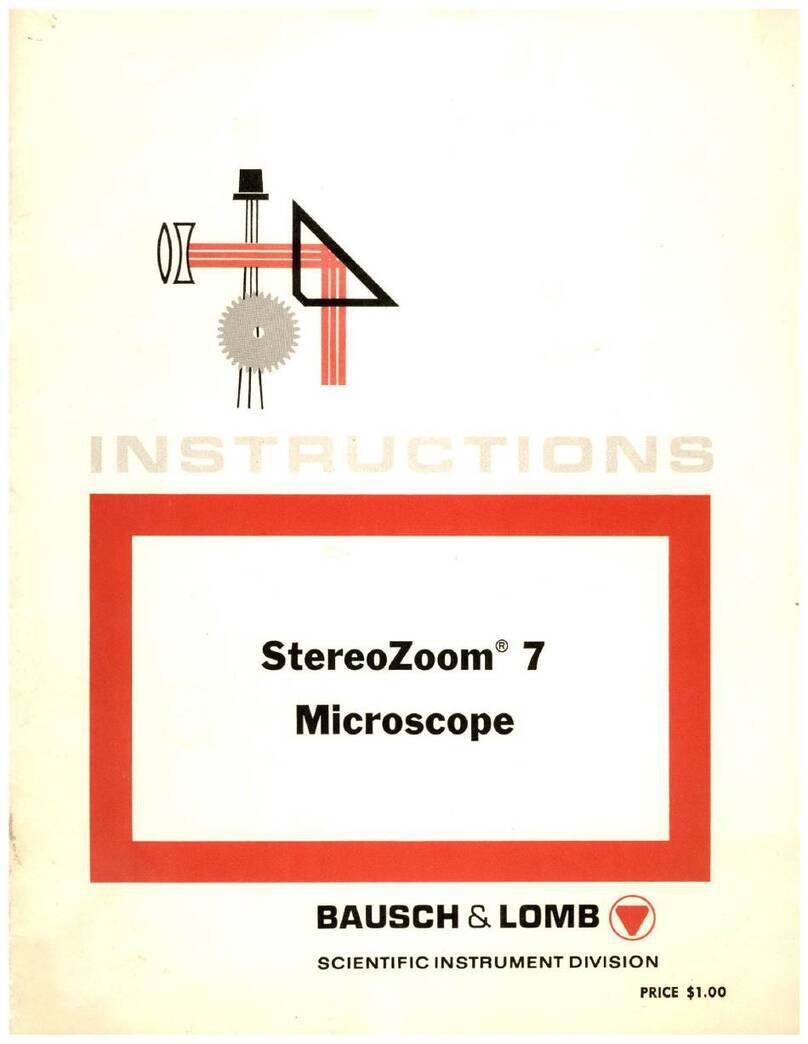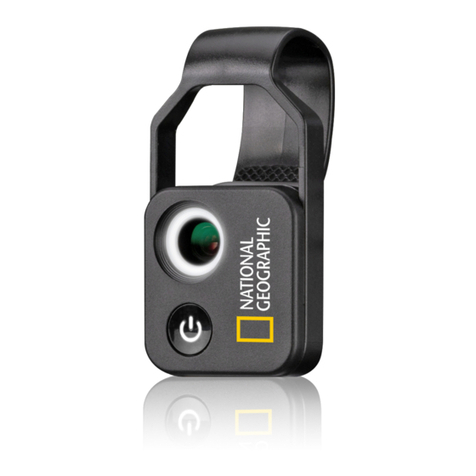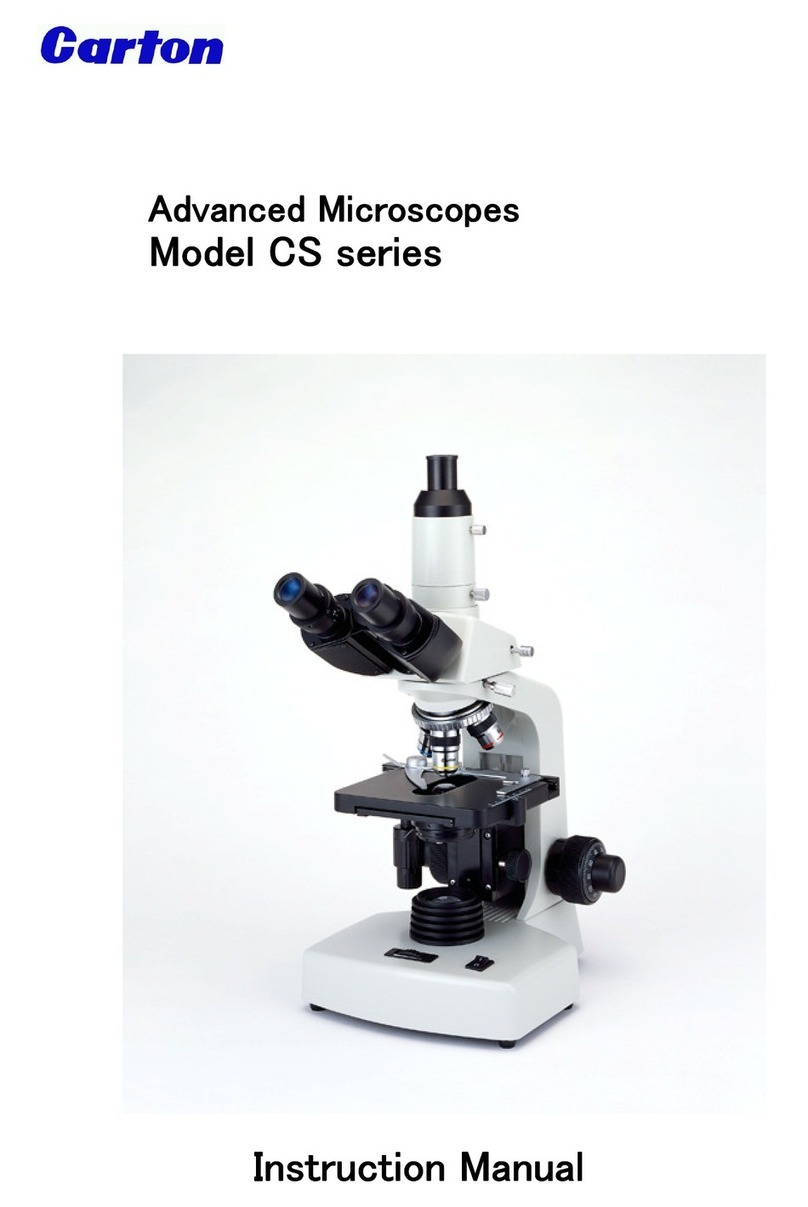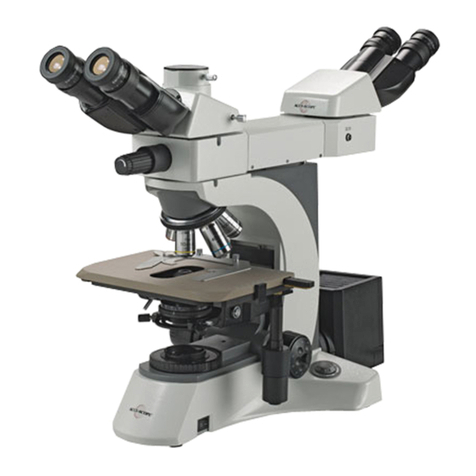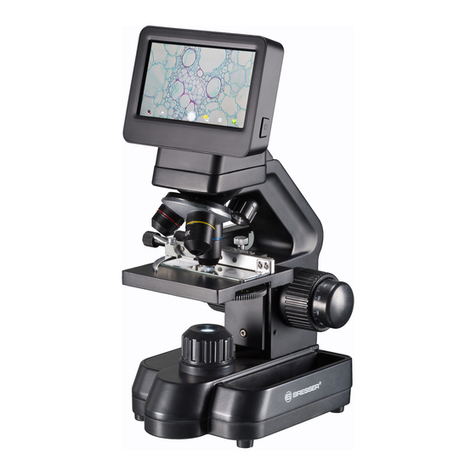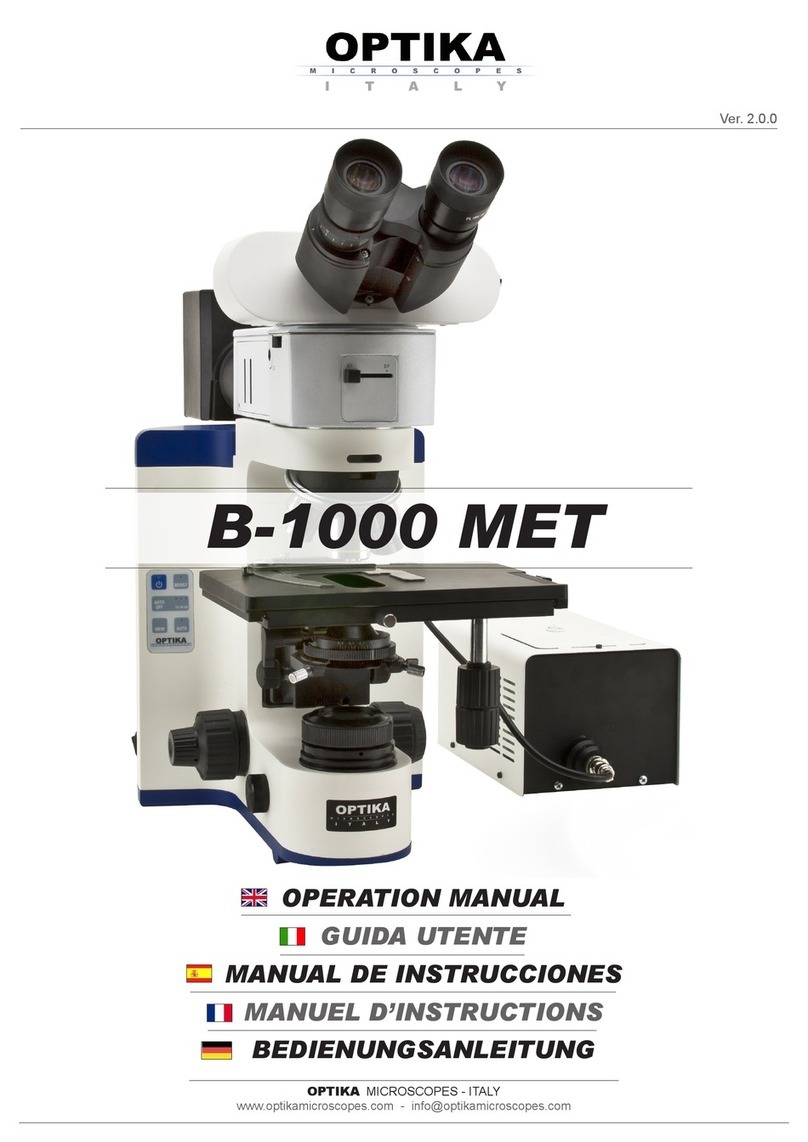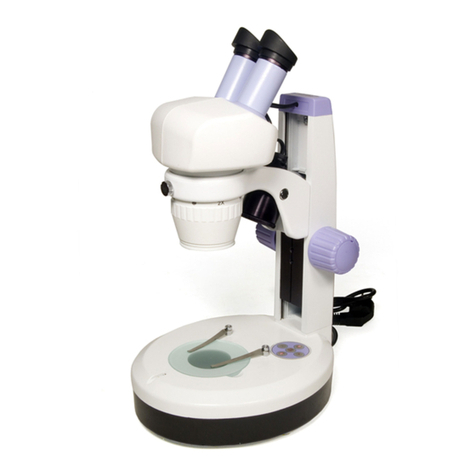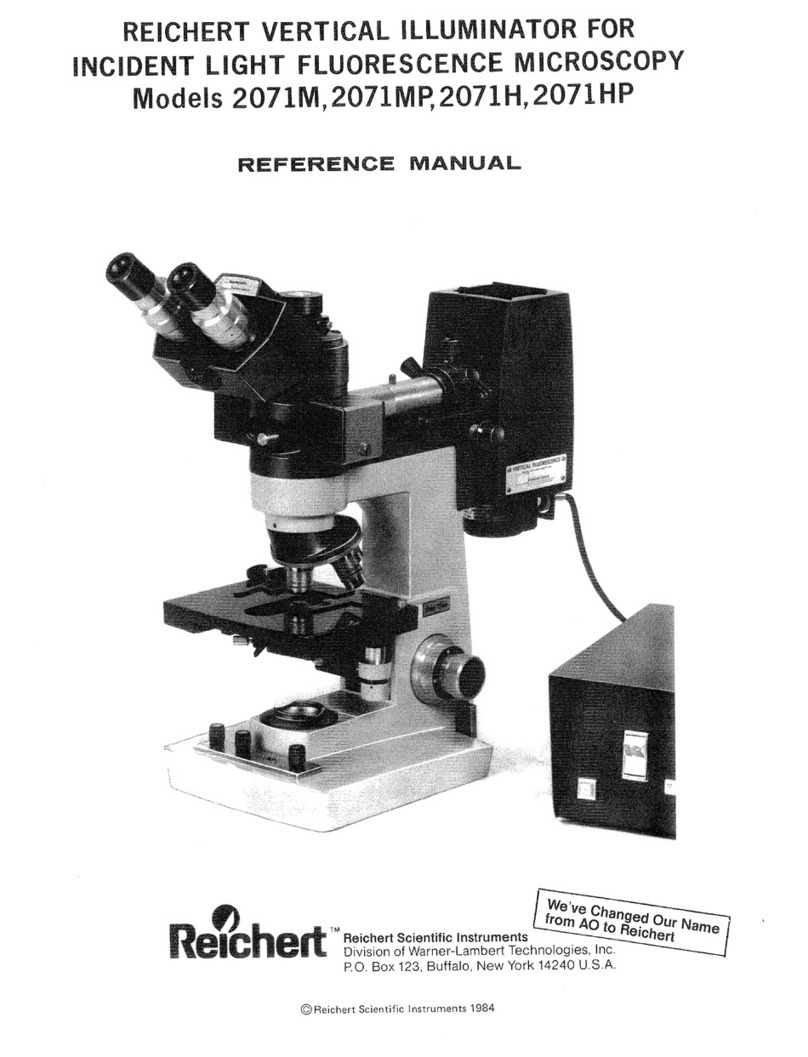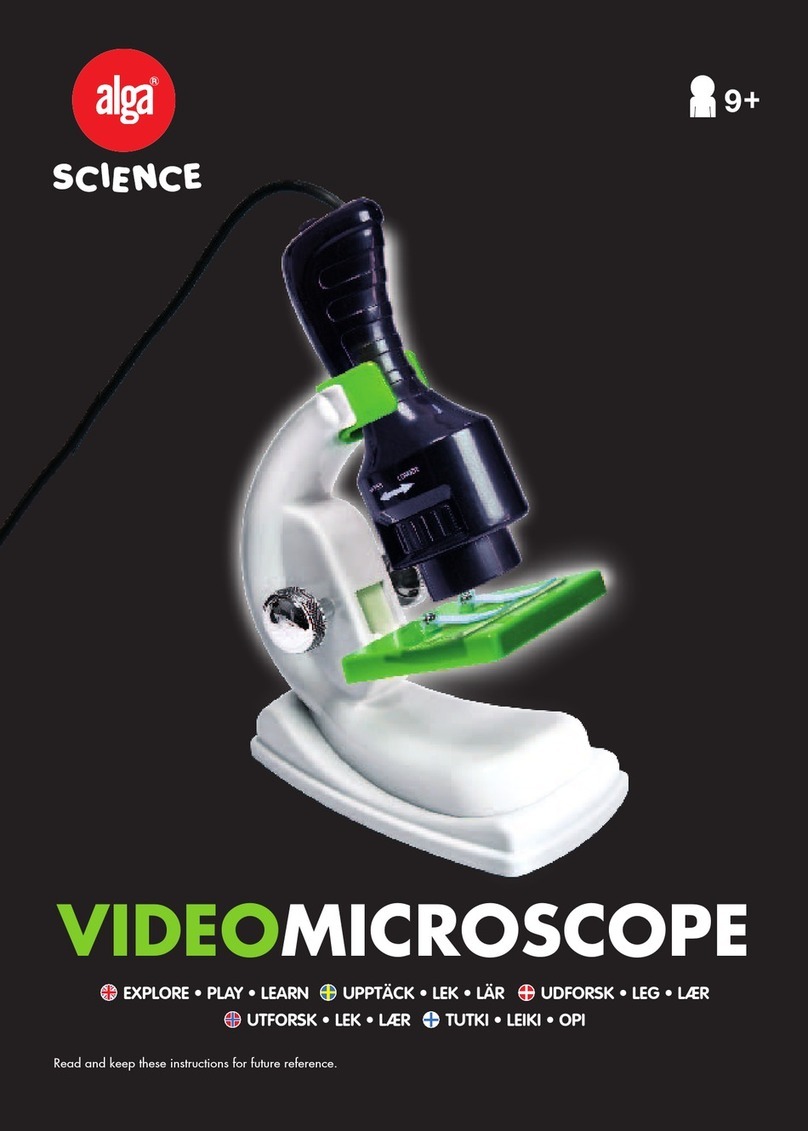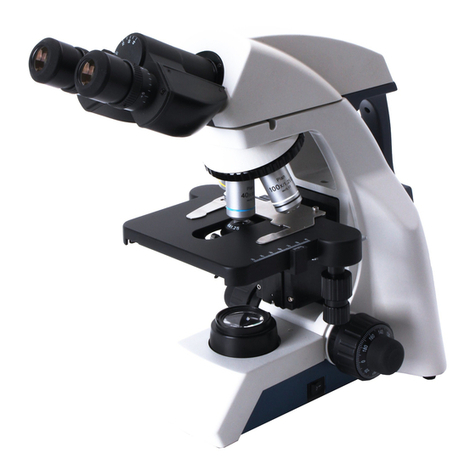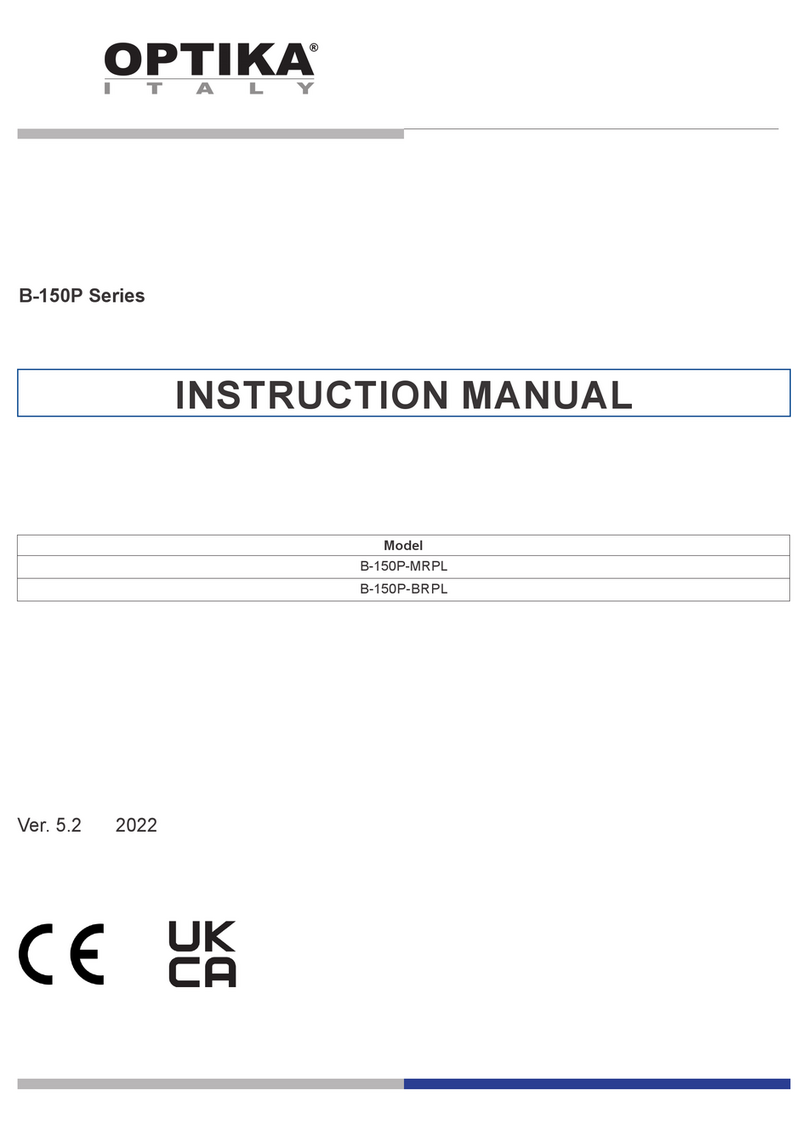Bausch & Lomb StereoZoom Series User manual

StereoZoom*
Series
Microscopes
INSTRUCTION
MANUAL
BAUSCH
&
LOMB
(9)
INSTRUMENTS
&
SYSTEMS
DIVISION
ROCHESTER,
NEW
YORK
14602 USA
716-338-6000,
TWX
510-253-6189
TELEX
97-8231,
CABLE:
BAUSCH
&
LOMB
StereoZoom
is
a
registered
trademark
of
Bausch
&
Lomb
Incorporated

StereoZoom
4
Pod
on
a
B
Stand
oNowAeN=
.
Eyepieces
Eyepiece
Adjusting
Ring
Magnification
Knob
Power
Pod
Arm
Illuminator
Stations
.
Objective
Cover
.
Spring
Clip
11
12:
13.
14.
18.
16.
StereoZoom
7
Pod
on
an
R
Stand
.
Glass
Stage
Plate
10.
3-Way
Mirror
(not
shown)
Trans-lllumination
Base
Mirror
Axie
Port
Hole
(not
shown)
Base
Upright
Focusing
Knob
Fa
18.
19.
20.
21.
22.
23.
.
Thumbwheel
Lock
Lever
Port
Hole
(not
shown)
Eyepiece
Adapter
Eyepiece
Ring
Thumbscrew
Base
Illuminator
Focusing
Slide

CONTENTS
Section
1.0
2.0
3.0
4.0
5.0
6.0
7.0
Introduction
Safety
Precautions
Unpacking
Preparation
for
Use
Mounting
the
Power
Pods
Changing
Stand
Working
Distance
Mounting
the
Illuminators
Trans-Illumination
Base
Operation
Interpupillary
Distance
Adjustment
Eyepiece
Locking
Feature
of
StereoZoom
5
Focusing
Fixed
Power
Pods
Focusing
Variable
Power
Pods
Changing
the
Magnification
of
Fixed
Power
Pods
Changing
the
Magnification
of
Variable
Power
Pods
Measuring
Procedure
Selecting
a
Reticle
Disc
Inserting
the
Reticle
Disc
Calibrating
the
Reticle
Special
Reticles
Installation
of
Supplementary
Lenses
Stereo
1
&
2
StereoZoom
3, 4,
5
StereoZoom
7
Maintenance
&
Service
Protecting
the
Microscope
and
Accessories
Cleaning
the
Optics
Adjusting
Focus
Tension
on
Arms
and
Stands
Lubrication
Service
Illumination
Illuminating
the
Specimen
Transparent
and
Translucent
Specimens
Diffuse
Opaque
Specimens
Specular
Specimens
Cavities
Illuminators
Nicholas
Illuminator
General
Purpose
Illuminator
Fluorescent
Illuminator
Reflector
Illuminator
Ring
Illuminator
Spot
llluminators
Coaxial
llluminator
Eyepiece
Illuminator
Vertical
Illumination
Attachment
Page
Section
1.0
8.0
Assembly
Views
and
Parts
List
Stereo
1
1.0X
Fixed
2.0
Power
Pod
31-26-91
Stereo
2
2.0X
Fixed
2.0
Power
Pod
31-26-92
StereoZoom
3
1.0X
thru
2.5X
Variable
4.0
Power
Pod
31-26-93
4.0
StereoZoom
4
0.7X
thru
3.0X
Variable
4.0
Power
Pod
31-26-94
4.0
StereoZoom
5
0.8X
thru
4.0X
Variable
4.0
Power
Pod
31-27-40
StereoZoom
7
1.0X
thru
7.0X
Variable
5.0
Power
Pod
31-27-01
5.0
A
Stand
31-26-88
B
Stand
5.0
B
Base
31-26-84
5.0
KT
Stand
31-26-65
5.0
K
Stand
31-26-95
S
Stand
31-27-14
5.0
SK
Stand
31-26-97
E
Stationary
Arm
31-26-59
5.0
ER
Rotary
Arm
31-26-90
5.0
10X
Eyepiece
for
Stereo
1
&
2,
5.0
StereoZoom
3,
4,5
31-15-71
51
15X
Eyepiece
for
Stereo
1
&
2,
5.1
StereoZoom
3,485
31-05-62
5.1
20X
Eyepiece
for
Stereo
1
&
2,
5.1
StereoZoom
3,4,587
31-05-63
5.1
15X
Eyepiece
for
52
StereoZoom
7
31-05-68
Supplementary
Lens
Attachments
for
6.0
Stereo
1
&
2,
StereoZoom
3,
4
&
5
0.5X
Lens
Attachment
31-26-18
6.0
2.0X
Lens
Attachment
31-26-19
6.0
Lens
Shield
31-26-21
Supplementary
Lens
Attachments
for
6.0
StereoZoom
7
6.0
0.25X
Lens
Attachment
31-27-08
6.0
0.5X
Lens
Attachment
31-27-04
1.5X
Lens
Attachment
31-27-05
70
2.0X
Lens
Attachment
31-27-06
7.0
Lens
Shield
31-27-35
9.0
Catalog
Items
7.0
Power
Pods
70
Stands
and
Arms
7.0
Stand
and
Arm
Accessories
TA
Eyepieces
and
Eyeguards
HA
Supplementary
Lens
Attachments
τα
Polarizing
Accessories
TA
Micrometer
Discs
ua
Cases
7.2
7.2
10.0
StereoZoom
Microscope
Tables
TR
Warranty
7.2
73
73
Page
8.1
8.2
8.3
83
8.5
8.8
8.9
8.9
8.10
8.11
8.13
8.13
8.14
8.14
8.15
8.15
8.15
8.15
8.16
8.16
8.16
8.16
8.16
8.16
9.0
9.0
9.0
9.0
9.0
9.0
9.0
9.0
9.1
10.0
10.2

1.0
Introduction
Image
excellence,
rugged
construction
and
exceptional
versatility
are
the
hallmarks
of
the
Bausch
&
Lomb
StereoZoom
series
of
stereo
microscopes.
These
features
are
in
keeping
with
a
tradition
of
quality
Bausch
&
Lomb
has
maintained
for
more
than
100
years
as
a
microscope
manufacturer.
The
StereoZoom
series,
introduced
by
Bausch
&
Lomb
in
the
1950's, has
become
the
world
standard
for
stereo
microscopes.
Since
its
introduction,
the
StereoZoom
series
has
undergone
constant
improvements
and
expansion
through
the
development
of
new
models
and
accessories.
Interchangeability
between
Power
Pods,
Stands,
Eyepieces,
Supplementary
Lenses
and
a
host
of
special
accessories
provides
the
user
with
a
nearly
limitless
choice
of
feature
combinations
which
permit
the
exact
tailoring
of
the
StereoZoom
equipment
to
the
requirements
of
the
task.
The
StereoZoom
series
can
be
used
to
advantage
for
nearly
any
visual
task
requring
3-D
observation
at
moderate
magnifications.
Frequently,
the
StereoZoom
series
offers
the
most
economical
approach
to
providing
microscope
magnification
even
when
there
is
no
requirement
for
3-D
observation.
Six
Power
Pods
form
the
nucleus
of
the
StereoZoom
series.
Two
of
these
are
fixed
power
while
four
of
them
provide
continuously
variable
magnification
by
means
of
operator
controlled
zoom
systems.
Eyepieces
and
Supplementary
Lenses
extend
the
magnification
ranges
of
these
Power
Pods
both
upward
and
downward.
All
optical
elements
are
sealed
into
the
Power
Pods
so
that
all
Pods
may
be
interchangeably
mounted
on
any
one
of
the
thirteen
Stands
and
Arms
offered
as
part
of
the
StereoZoom
series.
For
viewing
convenience,
the
Pods
may
be
turned
180
degrees
for
conventional
or
reversed
eyepiece
orientation.
Other
accessories
include
a
wide
choice
of
illuminators and
illumination
modes,
mechanical
stages
and stage
plates,
polarizing
accessories,
reticles
and
photographic
equipment.
Selection
of
the
right
combination
of
components
involves
consideration
of
cost,
magnification
range,
field
of
view,
working
distance,
eye
relief,
specimen
illumination
requirements
and
convenience
of
use.
With
this
in
mind,
descriptive
data
on
the
StereoZoom
series
components
are
presented
in
Section
9.0
of
this
manual
both
to
assist
you
in
interpreting
the
instructions
presented
here
and
to
help
you
more
fully
utilize
the
StereoZoom
equipment
you
already
have
purchased.
For
more
detailed
information,
send
for
the
latest
edition
of
Bausch
&
Lomb’s
StereoZoom
Microscope
Catalog.

2.0
Safety
Precautions
Many
of
the
StereoZoom
series
microscope
equipments
are
equipped
with
halogen
illuminators.
Please
note
the
type
with
your
equipment
and
follow
the
WARNING
set
forth
below.
WARNING:
The
Halogen-Cycle
Lamp
is
pressurized
and
may
shatter.
DO
NOT
operate
lamp
in
excess
of
rated
voltage
as
this
will
increase
lamp
pressure
and
the
risk
of
shattering.
Protect
the
lamp
against
abrasions
and
scratches
and
against
liquids
when
lamp
is
operating.
Replace
only
with
specified
replacement
lamp.
To
guard
against
personal
injury,
wear
protective
glasses
and
clothing
when
handling
lamp.
Turn
power
off
when
installing
and
before
removing
lamp.
Allow
lamp
to
cool
before
removing.
Dispose
of
lamp
with
care.
Do
not
operate
in
proximity
of
substance
or
material
that
is
flammable
or
adversely
affected
by
heat
or
drying.
3.0
Unpacking
Each
of
your
StereoZoom
series
microscopes
and
accessories
have
been
carefully
packaged
to
insure
that
they
reach
you
in
the
best
possible
condition.
Do
not
discard
any
packing
material
or
shipping
containers
until
you
have
assembled
your
equipment
and
checked
carefully
for
any
small
items
that
may
have
been
overlooked
2.0

4.0
Preparation
For
Use
Note: Parts
and
controls
referred
to
in
this
section
can
be
identified
by
referring
to
the
photographs
and
legend
preceding
Section
1.0
and
to
Section
8.0.
MOUNTING
THE
POWER
PODS
Power
Pods
can
be
mounted
on
any
Stand
or
Arm,
except
the
R
Stands,
by
simply
swinging
out the
two
Lock
Levers
at
either
side
of
the
Arm,
inserting
the
Pod
so
that
it
faces
either
forward
or
backward,
and
swinging
the
Lock
Levers
shut.
The
fit
between
Pods
and
Arms
is
intentionally
snug
to
prevent
movement
during
use.
Therefore,
be
sure
the
Pod
is
fully
seated
in
the
Arm.
On
R
Stands,
the
Power
Pod
is
retained
in
the
Arm
by
two
Thumb
Screws
instead
of
the
Lock
Levers.
CHANGING
STAND
WORKING
DISTANCE
The
Stands
have
provisions
for
a
wide
range
of
working
distances
when
Supplementary
Lenses
are
added
to
the
Pods.
increased
working
distance
can
be
accommodated
on
the
A
and
B
Stands
by
removing
the
four
screws
from
the
underside
of
the
Stand,
inserting
the
31-27-03
Elevator
between
the
Base
and
Upright
and
securing
with the four
screws
supplied
with
the
Elevator.
The
R
Stands
incorporate
a
built-in
provison
for
variable
working
distance.
To
change
working
distance,
remove
the
four
screws
which
secure
the
Focusing
Slide,
reposition
the
Arm
in
the
desired
location
and
reinstall
the
four
screws.
Three
positions
are
available.
MOUNTING
THE
ILLUMINATORS
All
Illuminators
for
StereoZoom
microscopes.
except
the
Coaxial,
Ring,
Eyepiece
and
Spot
Illuminators,
can
be
mounted
in
a
variety
of
ways,
either
free
standing
or
attached
to
a
Power
Pod
or
to
a
Stand.
Refer
to
the
Instruction
Manual
provided
with
your
Illuminator
for
specific
instructions.
TRANS-ILLUMINATION
BASE
The
B
Stand
for
StereoZoom
series
microscopes
is
designed
for
use
with
both
opaque
and
transparent
4.0
specimens.
This
stand
is
identical
to
the
A
Stand
except
with
the
addition
of
the
Trans-lllumination
Base,
which
includes
a
Clear
Glass
Stage
Plate
and
a
3-Way
Mirror.
The
3-Way
Mirror,
when
used
in
conjunction
with
a
Nicholas
or
General
Purpose
Illuminator inserted
in
the
Port
Hole
in
the
rear
of
the
Base,
can
be
used
to
provide
three
types
of
transmitted
illumination
for
the
examination
of
a
wide
variety
of
transparent/translucent
specimens.
When
looking
at
transparent
objects,
it
is
recommended
that
the
ground
surface
of
the
3-Way
Mirror
be
used
by
placing
the
Mirror
Axles
of
the
Base
in
the
lower
pair
of
Mirror
holes.
If
the
object
to
be
examined
is
translucent,
rotate
the
Mirror
to
use
the
reflective
surface.
If
the
specimen
is
transparent,
and
a
dark
field
illumination
effect
is
desired,
place
the
Mirror
Axles
in
the
upper
pair
of
holes.
For
transparent
objects
MOUNT
IN
THESE
L
HOLES
GROUND
SURFACE
REFLECTOR
For
translucent
objects
一
ーー
二
一
一
一
一
一
MOUNT
IN
THESE
CZ
^
HOLES
SILVERED
7
MIRROR
For
dark
field
effect
一
一
一
一
=
MOUNT
LL
IN
THESE
HOLES
一
一
一
一
—
===
—
SILVERED
—
>
MIRROR
These
diagrams
illustrate
the
mounting
positions
for
the
3-way
mirror.
For
the
examination
of
translucent
living
specimens,
the
use
of
the
cool,
white-light
Fluorescent
Illuminator
is
recommended.
Refer
to
the
Instruction
Manual
supplied
with
this
Illuminator
for
installation
instructions.

5.0
Operation
INTERPUPILLARY
DISTANCE
ADJUSTMENT
To
set
the
Eyepieces
for
your
proper
interpupillary
distance,
grasp
each
Eyepiece
Adapter
while
looking
into
the
microscope
and
move
the
Eyepieces
together
or
apart
until
you
see
the
full
field
of
view
with
both
eyes.
Check
this
by
closing
one
eye
and
then
the
other
without
moving
your
head.
Each
observer
must
adjust
the
interpupillary
distance
to
their
individual
requirements
and
should
recheck
it
each
time
they
use
the
microscope.
EYEPIECE
LOCKING
FEATURE
OF
StereoZoom
5
The
StereoZoom
5
Power
Pod
incorporates
an
Eyepiece
locking feature
which
lets
you
lock
the
Eyepiece
directly
into
the
Power
Pod
while
allowing
free
rotation
of
the
Eyepieces.
First,
roatate
the
inner
Eyepiece
Lock
Ring
until
the
Set
Screw
lines
up
with
the
access
hole
in
the
Eyepiece
Ring,
then
insert
the
hexagonal
Wrench
(supplied
with
the
Power
Pod)
into
the
Set
Screw.
Insert
the
Eyepiece
completely,
making
sure
that
it
seats
properly
on
its
locating
shoulder,
and
tighten
the
Set
Screw,
Repeat
the
above
procedure
for
the
other
Eyepiece.
FOCUSING
FIXED
POWER
PODS
1.
Illuminate
a
flat
specimen
and
then,
using
the
right
eye
only,
look
through
the
right
Eyepiece
and
focus
on
the
specimen
turning
the
Focusing
Knob
until
the
image
is
sharp.
2.
Look
through
the
left
Eyepiece,
and
using
only
the
left
eye,
rotate
the
Eyepiece
Adjusting
Ring
clockwise
or
counterclockwise
until
the
image
is
sharp.
Each
observer
must
focus
the
microscope
to
their
individual
requirements
and
should
recheck
it
each
time
they
use
the
microscope.
FOCUSING
VARIABLE
POWER
PODS
1.
Set
the
Magnification
Knob
to
the
lowest
power,
illuminate
and
center
a
flat
specimen
within
the
field
of
view.
Turn
the
Focusing
Knob
until
the
best
image
is
obtained.
2.
Set
the
Magnification
Knob
to
the
highest
power
and,
using
only
your
right
eye,
adjust
the
Focusing
Knob
until
the
image
is
sharp.
The
right
Eyepiece
is
now
properly
focused.
Note:
depth
of
field
decreases
as
magnification
increases.
It
is
many
times
greater
at
low
power
than
it
is
at
high
power.
This
means
that
while
it
is
quicker
and
easier
to
bring
the
specimen
into
focus
at
low
power,
the
most
critical
focus
can
only
be
achieved
at
high
power.
3.
Reset
the
Magnification
Knob
to
low
power
and,
using
only
the
left
eye, turn
the
Eyepiece
Adjusting
Ring
until
the
image
is
clear
and
sharp.
Make
sure
the
Eyepiece
shoulder
maintains
contact
against
the
Adjusting
Ring
shoulder.
The
left
Eyepiece
is
now
properly
focused
The
microscope
will
now
be
properly
focused
for
both
your eyes
throughout
the
magnification
range.
Each
observer
must
focus
the
microscope
to
their
individual
requirements
and
should
recheck
it
each
time
they
use
the
microscope.
Note:
Operators
who
normally
wear
glasses
with
a
correction
of
2
or
more
Diopters,
and
don’t
wear
them
when
using
the
microscope
may
find
refocusing
necessary
when
changing
magnification.
CHANGING
THE
MAGNIFICATION
OF
FIXED
POWER
PODS
The
magnification
provided
by
the
Fixed
Power
Pods
may
be
varied
by
using
different
Eyepieces
and/or
Supplementary
Lenses.
Total
Magnification
=
Fixed
Power
x
Eyepiece
Power
x
Supplementary
Lens
Power.
CHANGING
THE
MAGNIFICATION
OF
VARIABLE
POWER
PODS
The
Variable
Power
Pods
allow
you
to
change
the
power
continuously
to
exactly
the
best
magnification
for
a
given
specimen
by
simply
turning
the
Magnification
Knob
located
on the top
of
the
Power
Pod.
The
StereoZoom
Microscopes
allow
you
to
scan
an
object
at
a
lower
power
and
then
concentrate
on
some
particular
detail
by
increasing
the
power
gradually
to
the
desired
value.
The
power
range
can
be
further
extended
by
using
different
Eyepieces
and/or
by
adding
Supplementary
Lenses
below
the
Objective.
Total
Magnification
=
Variable
Power
x
Eyepiece
Power
x
Supplementary
Lens
Power.
MEASURING
PROCEDURE
StereoZoom
Microscopes
may
be
used
as
measuring
instruments
by
inserting
a
Reticle
in
one
of
the
Wide
Field
Eyepieces.
À
variety
of
linear
and
grid
patterned
Reticles
are
available
for
particualr
applications
as
well
as
Stage
Micrometers
for
calibrating
the
microscope.
These
are
described
in
Section
9.0.
SELECTING
A
RETICLE
DISC
Select
the
magnification
that
will
enable
you
to
see
the
necessary
detail
and
yet
cover
as
much
total
area
of
the
specimen
as
is
required.
Greatest
accuracy
will
result
from
measurements
made
within
the
central
%rds
of
the
field
of
view
in
a
north-south
direction.
After
the
magnification
has
been
selected
the
appropriate
reticle
disc
should
then
be
selected.
First,
decide
what
unit
you
desire
to
measure
the
specimen
by,
then
use
the
following
formula
to
determine
what
reticle
will
provide
that
unit:
SxM=K
Dimension
each
division
is
to
egual
in
the
specimen
plane.
M
=
Magnification
of
the
Power
Pod
only.
K =
Actual
dimension
of
each
smallest
division
on
the
reticle.
o
Il
5.0

Example:
Desired
dimension
on
specimen,
S
=
.002"'
Magnification
of
Power
Pod,
M
=
2X
Actual
dimension
of
division
on
reticle
(egual
to
.002“
on the
specimen)
would
be
K
=
.004
(approximately
0.1mm).
INSERTING
THE
RETICLE
DISC
Caution
Before
installing
a
Reticle
be
sure
it
is
free
of
dust,
lint,
smears,
etc.
To
clean
the
Reticle
wipe
its
surfaces
with
a
cotton
pad
moistened
with
a
mild
soap.
Rinse
and
dry
without
pressure
using
a
soft
lintless
cloth.
1.
Remove
the
black
cylindrical
Field
Diaphragm
by
unscrewing
it
from
inside
the
smaller
diameter
end
of
the
Eyepiece
(refer
to
the
Assembly
Views
on
page
8.14).
2.
Place
the
Reticle
into
the
thin
metal
rim
on
top
of
the
Field
Diaphragm
so
that
the
scale
will
face
towards
the
inside
of
the
Field
Diaphragm.
3.
The
thin
metal
rim
will
extend
beyond
the
surface
of
the
glass.
Using
a
pencil
with
eraser,
or
thumbnail
or
similar
object,
press
against
the
outside
of
the
rim
to
force
it
inward
and
downward
against
the
Reticle.
If
the
Reticle
is
to
be
temporarily
installed,
bend
in
the
metal
rim
at
three
points
around
the
glass.
If
the
Reticle
is
to
be
permanently
installed,
do
this
at
three
points
around
the
circumference
and
then
bend
the
rim
over
the
Reticle
around
the
whole
circumference
by
holding
the
mount
at
a
45°
angle
and
rolling
itona
hard
surface
such
as
a
table
top.
4.
Replace
the
Field
Diaphragm
and
Reticle
assembly
by
screwing
it
in
until
the
scale
comes
into
sharp
focus
when
viewed
through
the
Eyepiece.
5.
To
remove
the
Reticle,
press
against
the
scale
side
of
the
Reticle
and
push
it
out
of
its
mount.
CALIBRATING
THE
RETICLE
After
the
correct
Reticle
has
been
selected
it
must
be
calibrated.
If
the
Reticle
is
to
be
calibrated
in
inches
a
31-16-89
or
31-16-87
Stage
Micrometer
should
be
used.
If
the
Reticle
is
to
be
calibrated
in
millimeters
a
31-16-90
or
31-16-99
Stage
Micrometer
should
be
used.
For
the
most
accurate
calibration
and
measurements,
the
Reticle
and
the
Stage
Micrometer
both
should
be
positioned
in
the
north-south
direction.
The
Reticle
must
be
calibrated
for
each
objective
power
that
it
is
used
with
and
must
also
be
calibrated
for
each
StereoZoom
microscope
that
it
is
used
with.
4.
It
is
recommended
that
the
Eyepiece
containing
the
Reticle
be
placed
in
the
right
Eyepiece
Adapter.
2.
Place
the
appropriate
Stage
Micrometer
on the
Microscope
Stage
Plate.
3.
Focus
carefully
so
that
you
see
the
Stage
Micrometer
scale
sharply
in
focus
at
the
same
time
as
the
Reticle
scale
is
sharply
in
focus.
4.
Align
the
Reticle
scale
with the
Stage
Micrometer
scale
so
that
they
may
be
compared.
.
Read
the
number
of
scale
intervals
“b”
on
the
Stage
Micrometer
which
correspond
to
the
number
of
intervals
“a”
on the
Reticle.
One
interval
of
the
Reticle
then
corresponds
to
b/a
intervals
of
the
Stage
a
5.1
Micrometer.
Compute
this
ratio
and
use
it
to
make
measurements
in
the
specimen
plane.
SPECIAL
RETICLES
Often
industrial
or
experimental
applications
require
special
custom
made
scales
such
as
a
Reticle
that
could
be
used
as
a
“GO
-
NO
GO”
gauge.
For
a
quotation
on
special
reticles
to
your
specifications
write:
Bausch
&
Lomb
Dept.
7615
820
Linden
Avenue
Rochester,
NY
14625
In
your
request
state
the
objective
magnification
you
prefer
to
work
with
and
the
model
of
Wide
Field
Eyepieces
in
which
the
reticle
will
be
placed.
An
accurate
drawing
of
the
pattern
you
need,
fully
dimensioned,
must
be
submitted.
The
example
below
illustrates
the
kinds
of
dimensions
required.
3
CONCENTRIC
T
CIRCLES
DIAMETERS
‘pos,
006,
000
Se
À
a
si
y
er
그러
|
oan
mor
020
|
一
i
920"
TYPICAL
PATTERN
FOR
RULING
RETICLE
DISC
INSTALLATION
OF
SUPPLEMENTARY
LENSES
Until
you
are
familiar
with
the
installation
procedure
it
is
recommended
that
you
first
remove
the
Power
Pod
from
its
Stand
and
remove
the
Eyepieces,
turn the
Power
Pod
upside
down
and
install
the
Supplementary
Lens
as
noted
below,
then
insert
the
Power
Pod
back
in
its
Stand
and
replace
the
Eyepieces.
Once
you
have
become
familiar
with
the
procedure,
the
Supplementary
Lens
may
easily
be
installed
without
removing
the
Power
Pod
from
the
Stand.
Stereo
1&
2
StereoZoom
3, 4
&
5
Working
Cat.
No.
Distance
31-99-14
0.3X
276mm
Supplementary
Lens
(10%)
31-26-18
0.5X
178mm
Supplementary
Lens
(
7“)
31-26-19
2.0X
38mm
Supplementary
Lens
(1%!)

To
mount
one
of
these
Supplementary
Lenses,
simply
screw
it
into
the
large
diameter
thread
located
on the
bottom
of
the
Power
Pod
housing.
Make
sure
it
is
threaded
securely
against
the
shoulder.
NOTE:
If
the
threads
start
to
seize-up
during
installation,
apply
a
very
small
amount
of
oil
to
the
Lens
thread,
wipe
away
the
excess
and
reassemble.
The
0.3X
and
0,5X
Lenses
are
retricted
to
use
on
those
Stands where
the
working
distance
is
attainable
as
on
K,
KT,
S
or
SK,
or
the
A
and
B
Stands
when
used
in
conjunction
with
the
31-27-03
Elevator.
StereoZoom
7
Working
Cat.
No.
Distance
31-27-08
0.25X
266mm
Supplementary
Lens
(104)
31-27-04
0.5X
127mm
Supplementary
Lens
(5)
31-27-05
1.5X
32mm
Supplementary
Lens
(4)
31-27-06
2.0X
14mm
Supplementary
Lens
(9/16")
CAUTION
When
installing
or
removing
a
Supplementary
Lens,
be
careful
that
its
pins
do
not
scratch
the
objective
lenses
in
the
Power
Pod.
1.
Position'the
Supplementary
Lens
so
that
the
longer
pin
projects
perpendicular
to
the
flat
face
of
the
Power
Pod
as
shown
below.
2.
Seat
the
Supplementary
Lens
in
the
shallow
semicircular
recess
in
the
Power
Pod
and
rotate
it
clockwise
90°
until
it
clicks
into
position.
Check
to
see
that
it
is
properly
mounted
and
make
sure
that the
flat
side
of
the
Supplementary
Lens
is
aligned
with
the
flat
face
of
the
Power
Pod.
3.
To
remove
the
Supplementary
Lens,
rotate
it
counterclockwise
90°
and
then
remove
it
carefully
from
the
Power
Pod.
5.2

6.0
Maintenance
&
Service
PROTECTING
THE
MICROSCOPE
AND
ACCESSORIES
The
primary
rule
to
follow
with
respect
to
proper
care
of
microscopes
and
accessories
is
to
keep
them
as
free
from
dust
and
dirt
as
possible.
Dust,
fingerprints
or
a
smear
on
the
optics
will
degrade
the
image.
When
the
equipment
is
not
in
use,
cover
it
with
a
plastic
cover.
CLEANING
THE
OPTICS
The
Power
Pods
have
been
factory
aligned,
cleaned
and
sealed.
DO
NOT
attempt
to
disassemble
them.
Within
each
Eyepiece
Adapter
is
a
glass
dust
cover.
The
Eyepieces
should
be
kept
in
place
to
prevent
dust
from
settling
on
these
covers.
However,
if
dust
does
accumulate,
it
can
be
removed
by
unscrewing
the
Eyepiece
Adapter
and
wiping
the
dust
cover
with
a
soft
clean
cloth.
If
the
dust
is
gritty,
it
should
be
blown
off
with
an
air
syringe
or
wiped
off
with
a
cloth
or
cotton
swab
moistened
with
soap
and
water
or
alcohol
followed
by
a
thorough
wiping
with
a
dry
cotton
swab.
CAUTION
Avoid
excessive
use
of
solvents,
as
flowing
solvents
may cause
cement
run-in
on
cemented
optics,
making
cleaning
a
tedious
job.
ADJUSTING
FOCUS
TENSION
ON
ARMS
AND
STANDS
Both
Arms
and
all
Stands
except
the
R,
S
and SK
Stands
have
two hex
socket-head
Gib
Screw
B's
which
can
be
used
to
adjust
the
tension
of
the
focusing
mechanism.
By
turning
these
screws
slightly
clockwise
or
counterclockwise,
the
tension
can
be
increased
or
decreased.
When
making
this
adjustment,
be
sure
to
adjust
the
screws
in
the
same
direction
and
about
the
same
amount.
Each
R
Stand
is
factory
adjusted
to
establish
the
proper
balance
between
the
tension
of
the
focusing
mechanism
and
the
load
carrying
capacity.
After
considerable
use,
a
slight
readjustment
may
be
needed.
To
increase
the
focusing
tension,
tighten
the
hex
socket-head
screw
in
the
center
of
the
left
Focusing
Knob
about
1/12
of
a
turn
clockwise
using
a
7/64-inch
hex
wrench.
To
decrease
the
tension,
loosen
the
screw
about
1/2
turn
counterclockwise
and
pull
the
left
knob
outward
to
reduce
the
tension.
Then
tighten
the
screw
gradually
until
the
desired
tension
is
established.
LUBRICATION
Power
Pods
and
R
Stands
are
permanently
lubricated
at
the
factory
and
generally
do
not
require
periodic
6.0
lubrication.
If
cleaning
and
relubrication
become
necessary
as
a
result
of
abnormal
use
or
exposure
to
unusually
harsh
environments,
the
equipment
should
be
returned
to
the
factory
or
serviced
by
qualified
maintenance
personnel.
The
Focusing
Slide
on
all
stands
other
than
R
stands
should
be
wiped
clean
occasionally,
using
a
solvent
such
as
Xylol
or
alcohol,
and
relubricated
with a
light
coating
of
grease.
Alvania
+2
grease,
which
is
available
at
Shell
service
stations,
is
recommended
for
this
purpose.
SERVICE
All
optical,
electrical
and
mechanical
equipment
requires
periodic
servicing
to
keep
it
performing
properly
and
to
compensate
for
normal
wear.
Establishing
a
schedule
of
regular
preventive
maintenance
will
help
to
assure
long
life
and
sustained
optimum
performance
for
your
instrument.
It
will
also
help
to
avoid
unexpected
trouble
and
the
necessity
of
having
the
instrument
serviced
at
inconvenient
times.
A
program
of
planned
preventive
maintenance,
involving
a
thorough
cleaning,
checking
and
adjustment
of
mechanisms
is
recommended
for
all
instruments.
This
work
should
be
performed
by
qualified
personnel
with
the
proper
training
and
equipment.
Your
authorized
B&L
dealer,
or
Bausch
&
Lomb,
can
arrange
this
service.
IMPORTANT
If
unexpected
trouble
is
experienced
with
your
instrument,
contact
your
Bausch
&
Lomb
dealer.
He
may
be
able
to
suggest
simple
remedies
to
correct
the
apparent
difficulty
without
your
having
to
send
the
instrument
out
for
servicing.
Should
it
become
necessary
to
send
your
instrument
out
for
service:
Please
pack
the
instrument
carefully
in
a
crush
resistant
carton
with
at
least
three
inches
of
shock
absorbing,
dustless
material
surrounding
it
to
prevent
transit
damage.
Saving
the
original
carton
in
which
your
instrument
is
received
will
prove
helpful
for
this
purpose.
If
a
suitable
carton
is
not
available,
one
may
be
ordered
from
the
factory
at
nominal
cost.
Include
a
detailed
letter
in
the
shipping
carton,
preferably
fastened
to
the
instrument,
describing
the
trouble
experienced.
This
information
will
enable
the
service
technician
to
effect
required
repairs
promptly
and
at
least
expense.

7.0
ILLUMINATING
THE
SPECIMEN
The
full
potential
of
your
stereomicroscope
can
be
realized
only
if
the
microscope
is
equipped
with the
right
kind
of
illumination
system.
Equally
important
considerations
are
operator
comfort
and
efficiency,
which
also
depend
upon
specimen
illumination.
Providing
optimum
illumination
is
complicated
by
the
great
variety
of
specimens
which
are
examined
under
stereomicroscopes
and
by
the
very
nature
of
stereomicroscope
design.
A
StereoZoom
microscope
embodies
two
separate
and
complete
microscope
systems
mounted
at
different
viewing
angles
with
respect
to
the
specimen,
and
optimum
viewing
requires
a
critical
balance
between
the
illumination
supplied
to
the
two
microscope
systems.
No
single
Illuminator
is
capable
of
satisfying
the
requirements
for
all
kinds
of
specimens.
For
this
reason
Bausch
&
Lomb
offers
a
number
of
different
Illuminators.
Each
Illuminator
is
suitable
for
a
variety
of
specimen
types,
but
usually
there
is
a
“best”
Illuminator
for
each
specimen.
Following
are
some
general
suggestions
for
Illuminator
selection;
however,
it
may
be
necessary
to
do
a
little
experimenting
before
the
optimum
solution
is
reached
for
some
particularly
difficult
specimens.
TRANSPARENT
AND
TRANSLUCENT
SPECIMENS
For
these
specimens
a
properly
equipped
B
or R
Stand
is
recommended.
The
R
Stands
are
available
in
five
models,
two
of
which
have
built-in
Base
Illuminators and
Transformers
and
no
additional
equipment
is
required.
The
R
Stands
are
especially
recommended
for
photomicrography
with
the
StereoZoom
7
Power
Pod.
The
Fluorescent
Illuminator
is
recommended
for
use
with
the
B
Stand
when
highly
diffuse
illumination
is
required
(not
suitable
for
color
photomicrography).
For
more
intense
directional
illumination,
the
B
Stand
with
its
built-in
3-Way
Mirror
and
an
attached
Nicholas
or
General
Purpose
Illuminator
is
recommended.
The
focus
feature
of
the
General
Purpose
Illuminator
makes
it
the
better
choice.
Care
should
be
exercised
with
both
Illuminators
to
align
both
the
Reflector
and
the
Illuminator
so
that
balanced
illumination
is
provided
for
both
halves
of
the
microscope.
For
completely
transparent
specimens,
the
diffuse
side
of
the
Reflector
should
face
the
Illuminator
because
full
aperture
illumination
cannot
be
achieved
with
the
mirror
side
at
low
magnification
levels.
DIFFUSE
OPAQUE
SPECIMENS
In
general,
any
Illuminator
will
make
this
kind
of
non-reflective
specimen
visible
in
the
microscope;
however,
the
choice
of
Illuminators
will
have
a
profound
effect
on the
visibility
of
specimen
detail.
Contours
can
be
made
visible
by
the
shadows
cast
when
the
specimen
is
illuminated
from
one
side
only
and
at
a
large
angle
of
incidence.
Changing
the
Illuminator
position
will
enhance
some
details
while
suppressing
others.
When
desirable,
shadows
can
be
eliminated
completely
by
the
simultaneous
use
of
two
or
more
Illuminators
or
by
using
Illumination
an
omni-directional
source
such
as
the
Ring
Illuminator.
The
Ring,
General
Purpose
and
Reflector
IIluminators
are
recommended
for
use
on
large
objects
such
as
minerals,
coins,
electronic
and
mechanical
components,
gems
and
powders
and
for
dissecting
and
other
work
involving
the
manipulation
of
tools
under
the
microscope.
SPECULAR
SPECIMENS
Bright
field
illumination
of
specular
(highly
reflective)
surfaces
demands
that
the
optical
Law
of
Reflection
be
taken
into
account.
The
axis
of
the
Illuminator
must
be
positioned
so
that
after
reflection
from
the
specimen
surface,
the
direction
of
the
image-forming
rays
will
coincide
with
the
axes
of
the
microscope.
This
condition
can
be
fulfilled
by
tipping
the
specimen
and
orienting
the
Illuminator
as
illustrated
below.
Illuminator
Specimen
The
out-of-focus
condition
of
large
areas
of
the
specimen
image
which
results
from
this
method
of
illumination
can
be
avoided
completely
on
Stereo
1
&
2
or
StereoZoom
3,
4
&
5
Power
Pods
by
use
of
a
Spot
Illuminator
or
a
Vertical
Illumination
Attachment.
A
StereoZoom
7
Pod
equipped
with
a
Coaxial
Illuminator
will
also
eliminate
this
problem.
The
Coaxial
illumination
system
used
in
conjunction
with
the
StereoZoom
7
Power
Pod
is
applicable
to
nearly
all
kinds
of
specular
specimens,
with
the
images
of
polished
specimens
appearing
exactly
the
same
as
when
viewed
through
a
metallograph
or
metallurgical
microscope.
Somewhat
less
effective
illumination
for
specular
specimens
may
be
attained
with
all
StereoZoom
series
microscopes
by
adding
a
Vertical
Illumination
Attachment
to
the
Power
Pod and
by
employing
either
a
General
Purpose,
Nicholas
or
Reflector
Illuminator
7.0

attached
to
the
Stand
or
Power
Pod.
This
can
also
be
achieved
by
using
a
Spot
Illuminator
on
a
Stereo
1
or
2,
or
StereoZoom
3,
4
or
5
Power
Pod.
A
StereoZoom
microscope
equipped
for
vertical
illumination
is
shown
on
page
7.3
CAVITIES
Special
illuminators
are
generally
required
when
viewing
any
kind
of
opaque
or
translucent
surface
located
on
the
side
or
at
the
bottom
of
a
deep
cavity.
The
Spot
Illuminators
are
designed
primarily
for
cavity
illumination
or
wherever
a
compact
vertical
illuminator
is
required.
They
can
be
used
on
all
Power
Pods
except
the
StereoZoom
7.
Three
models
are
available,
each
being
GENERAL PURPOSE
ILLUMINATOR
WITH
IRIS
DIAPHRAGM
NICHOLAS
ILLUMINATOR
GENERAL
PURPOSE
ILLUMINATOR
WITH
IRIS
DIAPHRAGM
AND
FILTER
HOLDER
GENERAL
PURPOSE
ILLUMINATOR
GENERAL
PURPOSE
ILLUMINATOR
WITH
IRIS
DIAPHRAGM,
NICHOLAS
ATTACHMENT
AND
FILTER
HOLDER
Wal
designed
for
a
particular
working
distance
and
magnification
factor
as
described
on
page
7.2
The
Vertical
Illumination
Attachment
combined
with
either
the
Nicholas
or
General
Purpose
Illuminator
is
another
solution.
The
Vertical
Illumination
Attachment
work
with
all
StereoZoom
Pods.
ILLUMINATORS
There
are
eight
types
of
illuminators
which
may
be
use
with
StereoZoom
microscopes.
Nicholas
Illuminator
General
Purpose
Illuminator
Fluorescent
Illuminator
Reflector
Illuminator
Ring
Illuminator
Spot
Illuminators
Coaxial
Illuminator
Eyepiece
Illuminator
The
type
of
illuminator
chosen
is
determined
by
the
type
of
specimen,
the
area
of
the
specimen
which
mus
be
illuminated and
the
intensity
of
the
desired
illumination.
Whenever
possible,
mount
the
illuminator
the
microscope
so
that
the
illumination
stays
centered
the
microscope
is
focused
on
specimens
of
different
thickness.
NICHOLAS
ILLUMINATOR
provides
a
directional
concentrated
beam
of
relatively
high
intensity
light.
It
can
be
supplied
with an
adjustable
Linkage
and
a
three-step
variable
Transformer.
The
Nicholas
Illuminaf
may
be
mounted
in
the
hole
in
the
arm
of
the
A
Stand,
in
the
Stationary
Arm,
or
in
the
hole
at
the
rear
of
the
t
Base.
It
may
also
be
mounted
to
the
Linkage
which
mz
be
attached
to
either
of
the
two holes
in
the
Power
Pov
or
R
Stand,
or
fastened
directly
to
the
threaded
hole
ir
the top
of
the
Transformer
and
used
as
a
movable
source
to
bring
light
in
from any
direction.
In
its
variou
positions,
it
can
be
used
to
examine
opaque-diffuse
materials,
translucent
materials,
and
transparent
materials.
GENERAL
PURPOSE
ILLUMINATOR
provides
an
inter
spot
of
light
which
is
concentrated
in
a
relatively
small
field
and
focusable
from
three
inches
to
infinity.
It
can
be
supplied
with
a
3-step,
variable
Transforme
and
an
adjustable
Linkage.
When
equipped
with
a
Linkage,
the
General
Purpose
IIluminator
may
be
mounted
directly
to
the
StereoZoom
Power
Pod
or
R
Stand,
or
to
the
Transformer.
Four
accessories
have
been
designed
for
use
with
the
General
Purpose
Illuminator:
1.
The
adjustable
Iris
Diaphragm
is
an
aperture
contre
which
regulates
brightness.
Used
with
the
Nicholas
Attachment,
it
is
a
field
diaphragm
which
regulates
size
of
the
spot
of
light.
2.
The
Filter
Holder
holds
two-inch
round
or
square
filters
and
can
be
attached
to
the
basic
illuminator,
Iris
Diaphragm,
or
the
Nicholas
Attachment.
3.
The
Nicholas
Attachment
contains
a
focusable
telephoto
type
projection
lens
system
which
can
image
the
field
diaphragm
from
six
inches
to
infinity
can
be
used
with
or
without
the
Iris
Diaphragm
and
the
Filter
Holder.

4.
The
Cone
Adapter
attaches
to
the
illuminator
housing
or
the
Iris
Diaphragm
permitting
the
illuminator
to
be
mounted
in
the
E
Arm,
A
stand,
B
Base
or
the
Nicholas
Adapter
on
an
ER
Arm
FLUORESCENT
ILLUMINATOR
provides
a
cool
diffuse
light
of
daylight
character.
When
it
is
mounted
in
the
base
of
the
B
stand,
it
may
be
used
to
examine
transparent
specimens.
When
it
is
mounted
on the
Linkage,
it
may
be
used
to
examine
opaque
materials.
It
is
especially
effective
where
surfaces
are
highly
reflective.
The
Fluorescent
Illuminator
is
particularly
useful
for
examining
live
specimens
because
its
light
is
cool.
REFLECTOR
ILLUMINATOR
gives
moderately
directional
lighting
of
a
fairly
high
intensity.
It
illuminates
a
general
area.
It
is
a
versatile
illuminator
and
can
be
used
with
opaque-diffuse
materials
and
translucent
materials.
RING
ILLUMINATOR
The
source
is
a
dual
concentric
ring
fiuorescent
tube
providing
cold
light
of
daylight
quality.
The
lamp
is
mounted
on
a
StereoZoom
Power
Pod
by
means
of
a
coupler
and
on
the
StereoZoom
7
by
means
of
a
converter
and
coupler.
Use
in
conjunction
with
the
B&L
Coaxial
Illuminator
System
results
in
very
effective
shadowless
illumination
of
the
specimen
SPOT
ILLUMINATORS
are
available
in
three
models
to
provide
vertical
illumination
for
all
StereoZoom
series
Power
Pods
except
the
StereoZoom
7
The
three
models
offer
a
range
of
working
distance
from
3"
to
10”
with
magnification
factors
of
1.0X,
0.5X
and
0.3X
to
provide
vertical
illumination
for
the
examination
of
PC.
boards,
cracks,
crevices
and
holes
up
to a
depth
of
10”.
These
compact
illuminators
attach
to
the
bottom
of
the
Power
Pods
by
means
of
a
threaded
adapter
and
provide
an
uncluttered
work
space above
and
around
the
specimen.
COAXIAL
ILLUMINATOR
for
StereoZoom
7
only
is
an
ideal
illuminator
for
viewing
flat,
highly
reflective
specimens,
and
is
a
compact
unit
which
allows
complete
flexibility
of
the
StereoZoom
7
Microscope.
It
is
equipped
with
green,
yellow,
and
daylight
blue
filters
in
a
unique
rotating
turret.
The
easily
changed
lamp
is
powered
by
a
three-tap
Transformer.
The Coaxial
Illuminator
must
be
installed
to
the
StereoZoom
7
Power
Pod
at
the
factory.
GENERAL
PURPOSE
ILLUMINATOR
WITH
CONE
ADAPTER
FLUORESCENT
ILLUMINATOR
REFLECTOR
ILLUMINATOR
RING
ILLUMINATOR
oF
SPOT
ILLUMINATOR
COAXIAL
ILLUMINATOR
7.2

EYEPIECE
ILLUMINATOR—designed
primarily
for
use
with
the
StereoZoom
7
Power
Pod
when
equipped
with
a
photomicrographic
system
or
viewing
screen.
It
provides
the
same
efficient
illumination
as
a
Coaxial
Illuminator
for
precise
examinations
of
multilayer,
flat,
and
opaque
objects
in
semiconductor
and
electronics
applications.
Includes
a
built-in
filter
holder
for
accepting
any
of
several
available
13/16"
diameter
filters.
VERTICAL
ILLUMINATION
ATTACHMENT
If
straight
top
lighting
is
necessary
to
bring
out
surface
detail,
one
of
the
external
illuminators
already
mentioned
may
be
used
in
combination
with
the
Vertical
Illumination
Attachment.
This
Attachment
has
no
light
source
of
its
own.
Instead,
it
has
a
mirror
system
which
reflects
light
directly
downward
on
the
specimen.
The
Vertical
Illumination
Attachment
is
especially
useful
for
examining
interior
surfaces
of
castings
or
machined
parts,
cracks,
holes
and
crevices.
The
Vertical
Illuminator
Adapter
is
attached
to
the
bottom
of
the
Power
Pod
in
the
same
manner
as
a
Supplementary
Attachment
Lens,
oriented
as
necessary
and
clamped
in
place
by
a
thumb
screw.
$F.
De
VERTICAL
ILLUMINATION
ATTACHMENT
WITH
GENERAL
PURPOSE
ILLUMINATOR
7.3
EYEPIECE
ILLUMINATOR

8.0
Assembly
Views
and
Parts
Lists
8.0

STEREO
1
1.0X
Fixed
Power
Pod,
Cat.
No.
31-26-91
Key
Description
Part
No.
1
Eyepiece
Ring
312694-175
2
2-64T
x
ho
Set
Screw
312701-379N
3
Eyepiece
Adapter
312694-369
4
Ret.
Ring
312694-321
5
Dust
Seal
Cap
312694-259
6
Dust
Seal
312740-129
7
Eyepiece
Adj.
Ring
312694-129
8
Pivot
Screw
A
312694-144
9
Mirror
Housing
312691-126
10
F-309
Washer
90008-377
11
F-108
Washer
90008-281
12
Adapter
312694-269
13
Dust
Seal
Washer
312694-234
14
4-48
x
%
Set
Screw
315153-120N
15
Dust
Cover
312694-052
16
Body
Tube
312694-277
17
Pin
312799-171
18
Eyepiece
Mount
Support
312799-102
19
Housing
312692-105
20
8-32G10S
Screw
96208-0808
21
Objective
Cover
312694-370
22
6-32
x
%e
Ig
Screw
316012-150
23
6-40
x
7%:
lg
Screw
312694-125
24
4-48
x
%«
Screw
312694-326
ト
25
F-120
Washer
90008-125
26
Eyepiece
Mount
Right
312799-116
Eyepiece
Mount
Left
(not
exploded)
312799-115
*27
Mirror
Mount
Right
Assy
312694-376
Mirror
Mount
Left
Assy
(not
exploded)
312694-375
28
Lens
Mount
312691-101
29
Lens
AB
Assy
312691-023
30
Retainer
Ring
423496-106
31
8-36
x
%2
Screw
312694-327N
32
6-40T
x
%
Screw
312694-324N
*Sold
in
assembled
units
only.
8.1

Key
827
28
29
30
31
32
Description
Eyepiece
Ring
2-64T
x
As Set
Screw
Eyepiece
Adapter
Ret.
Ring
Dust
Seal
Cap
Dust
Seal
Eyepiece
Adj.
Ring
Pivot
Screw
A
Mirror
Housing
F-309
Washer
F-108
Washer
Adapter
Dust
Seal
Washer
4-48
x
4
Set
Screw
Dust
Cover
Body
Tube
Pin
Eyepiece
Mount
Support
Housing
8-32G10S
Screw
Objective
Cover
6-32
x
%s
lg
Screw
6-40
x
2%:
lg
Screw
4-48
x
%s
Screw
F-120
Washer
Eyepiece
Mount
Right
Eyepiece
Mount
Left
(not
exploded)
Mirror
Mount
Right
Mirror
Mount
Left
(not
exploded)
Lens
Mount
Lens
AB
Assy
Retainer
8-36
x
%z
Screw
6-40T
x
%
Screw
*Sold
in
assembled
units
only.
Part
No.
312694-175
312701-379ND
312694-369
312694-321
312694-259
312740-129
312694-129
312694-144
312692-123
90008-377
90008-281
312694-269
312694-234
315153-120ND
312694-052
312694-277
312799-171
312799-102
312692-105
96208-0808
312694-370
316012-150
312694-325ND
312694-326ND
90008-125
312799-116
312694-374
312694-373
312692-101
312692-023
312692-102
312694-327ND
312694-324ND
Stereo
2
2.0X
Fixed
Power
Pod,
Cat.
No.
31-26-92
8.2

StereoZoom
3
1.0X
thru
2.5X
Variable
Power
Pod,
Cat.
No.
31-26-93
StereoZoom
4
0.7X
thru
3.0X
Variable
Power
Pod,
Cat.
No.
31-26-94
Key
Description
STEREOZOOM
4
1
6
ら
oo
の
の ょ
oN
11
12
13
*14
18
19
20
21
22
23
24
25
26
27
28
29
30
31
32
33
34
35
36
37
38
39
40
41
42
149
47
48
49
50
52
53
54
55
8.3
Eyepiece
Ring
2-64T
x
No Set
Screw
Eyepiece
Adapter
Dust
Seal
Cap
4-48
Set
Screw
Dust
Cover
Dust
Seal
Eyepiece
Adj.
Ring
Mirror
Housing
Ret.
Ring
Adapter
Dust
Seal
Washer
Spring
Pin
Body
Tube—must
be
assembled
with
key
43
Mirror
Mount
Right
Assy
Mirror
Mount
Left
Assy
(not
exploded)
Eyepiece
Mount
Support
Tru-Arc
Ret.
5133-25
F-310
Spring
Washer
Screw,
6-32
x
%
Bearing
Screw
(4)
F-306
Washer
Lock
Nut
Gear
Drive
Support
Ball
.1562
Ø
(4)
Lead
Screw
Mount
6-40
x
%
Screw
F-306
Washer
Lens
E-F
Assy
Retainer
E-F
Lens
Mount
2-56
x
Ke
Screw
(2)
Retainer
Cover
Gasket
6-40
x
2%2
Screw
6-32
x
%2
Screw
Pivot
Screw
“A”
F-309
Washer
F-108
Washer
Screw,
4-48
x
Ув
F-120
EP
Mount
Right
(refer
to
key
14)
EP
Mount
Left
(not
exploded)
Mount
AB
Objective
Driven
Gear
2
Gear
Lock
Nut
Cell
Mount
B
&
Pad
Assy
AB
Lens
Assy
Magnification
Knob
Assy
Washer
F-304
Set
Screw
Part
No.
312694-175
312701-379ND
312694-369
312694-259
315153-120ND
312694-052
312740-129
312694-129
312694-367
312694-321
312694-269
312694-234
312799-171ND
312694-277
312694-376
312694-375
312799-102
312695-111ND
90008-378
312694-329ND
312694-118
90008-369
312694-322
312799-107
312694-152ND
312799-265
312694-328ND
90008-369
312694-029
312692-102
312799-256
312694-302ND
312692-102
312694-312
312694-325ND
316012-150
312694-144
90008-377
90008-281
312694-326ND
90008-125
312799-116
312799-115
312799-272
312694-121
312694-169
312694-351
312694-023
312694-366
90008-367
312694-236ND
Key
56
#57
358.
#59
61
62
63
64
65
66
67
68
69
70
71
73
74
75
76
77
78
81
Description
Washer
Drive
Gear
Shaft
F-305
Washer
Objective
Drive
Gear
Set
Screw
Lead
Screw
&
Gear
Assy
L.H.
Lead
Screw
&
Gear
Assy
R.H.
(not
exploded)
2-56
x
.312
LG
Screw
F-119
Washer
F-132
Washer
(not
shown)
Cover
Cover
Spring
Рад
“В”
Objective
Mount
Cover
Cell
Mount
A
Pad
Assy
Lens
CD
Mount
Cd
Lens
Assy
2-64
x
‘42
Ig
Spline
Set
Screw
(8)
Guide
Bar
Screw,
8-36
x
%2
Lens
E-F
Assy
Objective
Cover
Objective
Driven
Gear
RH
6-40
x
%
Screw
STEREOZOOM
3
All
parts
are
similar
to
those
for
the
31-26-94
Power
Pod
except:
9
53
*57]
*58
*59
*60)
Mirror
Housing
Magnification
Knob
Assy
Drive
Gear
&
Shaft
Assy
*Sold
in
Assembled
Units
Only
Part
No.
312694-141
312694-139
90008-368
312694-120
312694-229ND
312694-201
312694-266
312694-292ND
90008-124
90008-142
312799-178
312694-372
312694-105
312799-178
312694-348
312799-274
312694-037
312694-310ND
312694-106
312694-327ND
312694-029
312694-370
312694-264
312694-324ND
312693-141
312693-140
312693-132

ss
EN
<
©
Sr
Se
(8°
Z
HEVET
+
p
y

StereoZoom
5
0.8X
thru
4.0X
Variable
Power
Pod,
Cat.
No.
31-27-40
oo
ς
8.5
This manual suits for next models
3
Table of contents
Other Bausch & Lomb Microscope manuals
Popular Microscope manuals by other brands
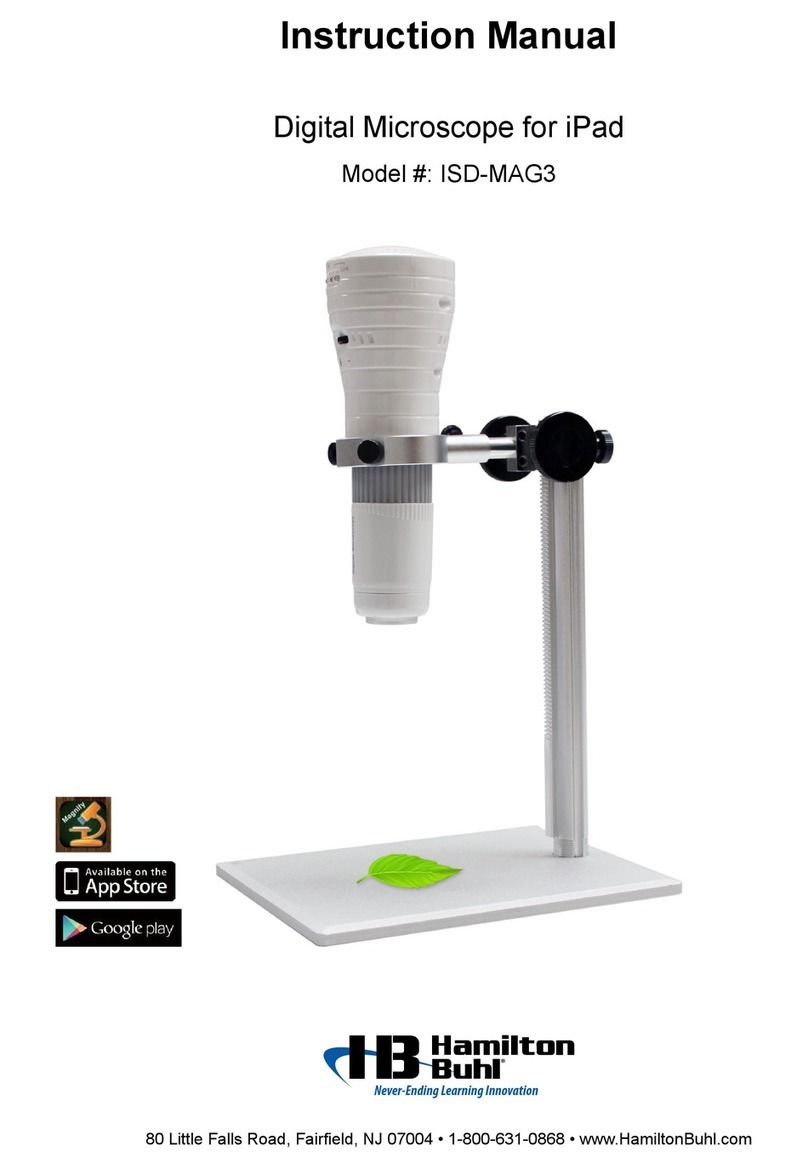
Hamilton/Buhl
Hamilton/Buhl ISD-MAG3 instruction manual
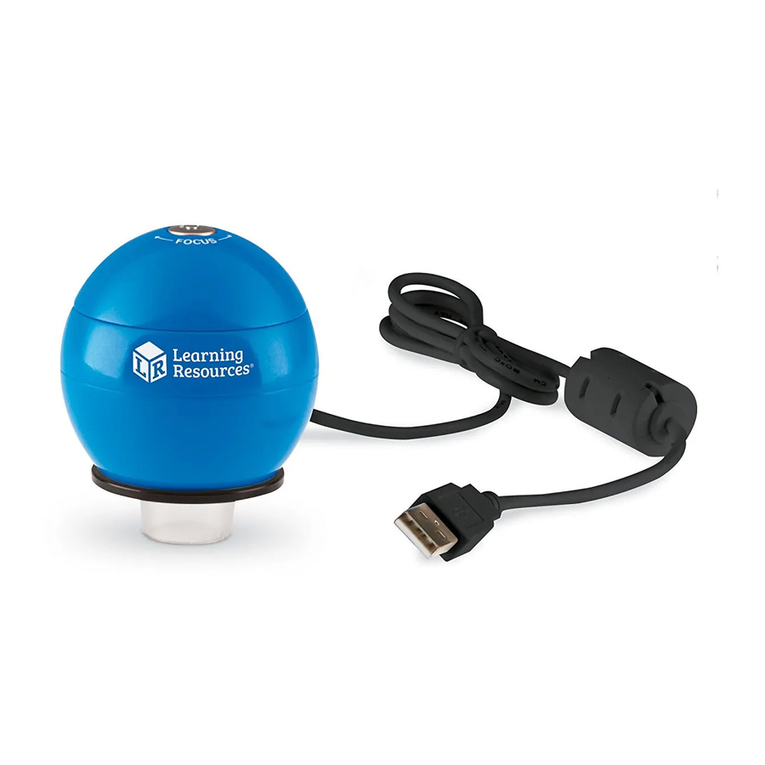
Learning Resources
Learning Resources Zoomy 2.0 instruction manual

3B SCIENTIFIC PHYSICS
3B SCIENTIFIC PHYSICS 500 1003279 instruction manual

Leica
Leica DM750 M user manual
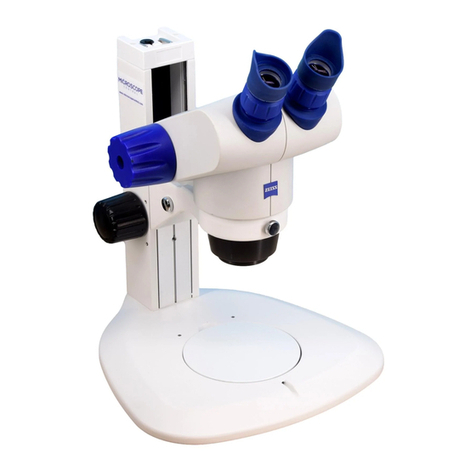
Zeiss
Zeiss Stemi DV4 operating instructions
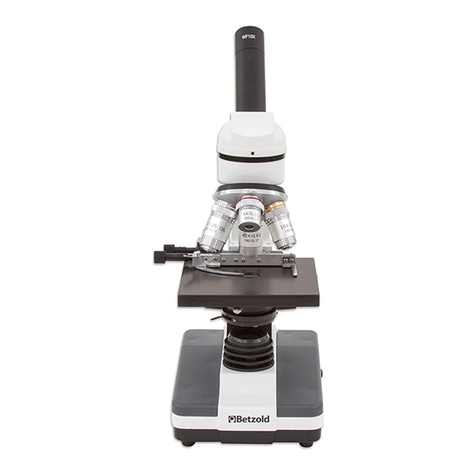
Betzold
Betzold M-06 instruction manual
